Japanese Food 日本料理
|
Title   • File Name • File Name   • Date • Date   • Position • Position   |
|

Preparing unagi eel, Narita, Chiba. Also see the video at YouTube.Slicing it in half lengthwise.
|
|

Striping off the boney spine.
|
|
|

Mini octopus
|
|

It is really good! Different flavors are offered during different days of the tournament. Top is shoyu (soy sauce) flavor, and bottom is salt flavor. Miso flavor is also offered.
|
|

Natto fermented beans
|
|

My lunch. Ball-shaped gyoza. The skin is slightly crunchy.
|
|

Yokosuka curry
|
|
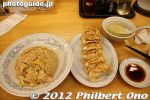
Cha-han fried rice and gyoza
|
|
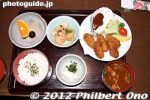
Fried oysters in Hiroshima.
|
|
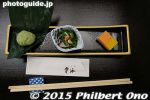
Appetizer, Kyoto
|
|
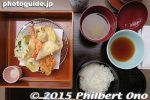
Tempura
|
|

Kaki-fry teishoku or fried oysters
|
|

Shabu-shabu dinner with the shabu-shabu pot having a divider so we can try two different flavored broths.
|
|

Sukiyaki dinner
|
|
|
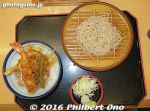
Small tempura donburi and cold soba noodles at Tenya
|
|
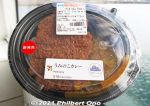
My lunch on the boat was Uminoko Curry, the same dish served on the Uminoko Floating School.
|
|
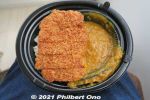
Uminoko Curry had pork cutlet and kind of sweet, mild curry. Sold only by 7-11 in Shiga for a limited time of three weeks from late Jan. 2021. Best place to eat it was on Lake Biwa.
|
|

Inside the ceramic flask they bake sweet potatos.
|
|
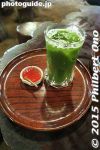
Ordered matcha tea
|
|
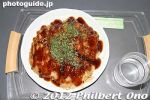
Hiroshima is also famous for okonomiyaki.
|
|
|
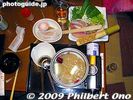
Nabe (stew) with vegetables and some pork. Cook it yourself.
|
|

Chanko nabe, a meat and vegetable stew eaten by sumo wrestlers. Served at the Ryogoku Kokugikan during sumo tournaments.
|
|
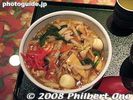
Chuka-don or a bowl of rice with vegetable topping. 中華丼
|
|
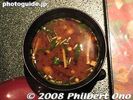
Dark miso soup with small mushrooms. (Came with the chuka-don.)
|
|

Udon with raw egg
|
|

Looks like fried chicken with goya (bitter melon) and udon noodles.
|
|

Kaki-fry teishoku or fried oysters in a complete meal.
|
|

Steamed rice with small clams.
|
|
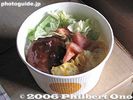
Japanese-style Locomoco, originally from HawaiiFrom a well-known bento shop. Not very good.
|
|

Making okonomiyaki
|
|

Making okonomiyaki
|
|

Okonomiyaki is like a pancake with vegetables and meat.
|
|

Okonomiyaki with sauce and ready to eat. Osaka.
|
|

Funa-zushi or fermented carp fish from Lake Biwa. 鮒ずしDelicacy of Shiga Prefecture.
|
|

Omi beef
|
|

Sashimi donburi
|
|

Tempura mushroom
|
|

Rice with shellfish
|
|
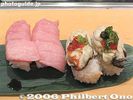
Toro and oyster (kaki) Sushi
|
|

Okonomiyaki (Osaka)
|
|

Tempura teishoku at Tenya
|
|
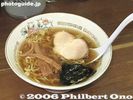
Ramen
|
|
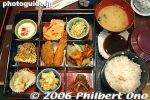
Chinese dinner
|
|

Making okonomiyaki
|
|

Puffer/balloon fish totally unaware of their ultimate fate.
|
|

Sake rice wine
|
|

Tempura and more
|
|

High-class meal
|
|
|

Kamaboko fish cakes from Himi, Toyama
|
|

Funa-zushi, Shiga Prefecture. Fermented carp.
|
|
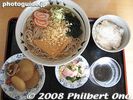
Soba noodles with daikon and rice. A perfect winter meal.
|
|
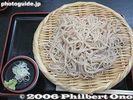
Cold soba noodles
|
|

Shellfish
|
|

Sashimi
|
|
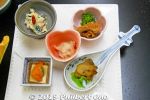
Appetizers.
|
|
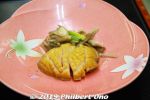
Abalone steak.
|
|
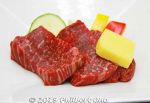
Local Hitachi Wagyu beef. ("Hitachi" is an old name for Ibaraki Prefecture. The famous electronics company Hitachi is also from Ibaraki.) 常陸牛
|
|
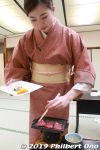
Hotel staff in kimono cooking my Hitachi Wagyu beef. 常陸牛
|
|
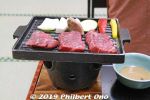
Hitachi Wagyu beef was just a small part of our dinner. We got really stuffed. 常陸牛
|
|
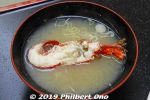
Lobster in miso soup.
|
|
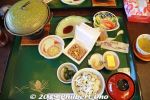
Breakfast included natto fermented soybeans. Ibaraki is famous for natto.
|
|
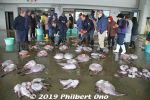
Hirakata Port's main catch is the monkfish/goosefish (あんこう), a type of anglerfish. Ibaraki Prefecture's coast is one of Japan's prime areas for monkfish. These are all monkfish being auctioned in the afternoon. 平潟港 せり見�
|
|
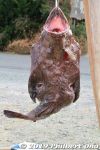
It's Kita-Ibaraki's famous fish and delicacy, monkfish, in the flesh. This one is 5 or 6 years old, weighing 12.7 kg. Only the female monkfish is eaten. The males are too small.あんこう
|
|
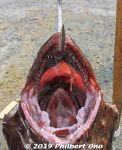
Look into the big mouth and see another set of teeth on the throat. All the teeth are pointed inward so its pray cannot escape. Like the aliens in the movie "Alien."
|
|
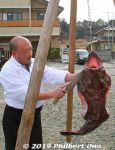
Monkfish being skinned and carved up by an expert chef. Since the monkfish is too slimy and slippery on a cutting board, it is hung like this for carving. It's a lot easier to cut up this way.He first takes off the skin (loaded with collagen).
|
|
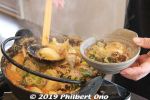
This is monkfish hot pot (dobojiru ankou-nabe) どぶ汁 with monkfish parts in a miso broth. I didn't have any problem eating it. The flavor was certainly not objectionable, it's just another kind of fish.It was already prepared for us and it wasn't the fish we saw carved.
|
|
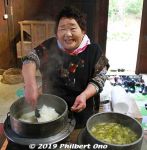
At Arigatee, we were charmed by the delightful Sumi-chan, a retired local farmer. She helped cook our lunch. Rice locally grown in Kita-Ibaraki. Thank you Sumi-chan for smiling!
|
|
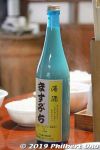
Local sake, a type called Doboroku (どぶろく) or nigori-zake (濁り酒). It's thick and cloudy-white. Sour taste. Made by a local brewer and restaurant named Masubuchi (増渕魚園).
|
|
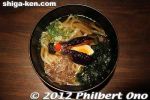
Hotaru (firefly) udon served by the Kashiwa restaurant inside Kashiwabara-juku History Museum in Maibara, Shiga. Firefly made of eggplant with the light from an egg slice.
|
|
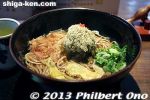
Yaito udon served by the Kashiwa restaurant inside Kashiwabara-juku History Museum in Maibara, Shiga. Yaito is moxa. The red dot (red ginger) is the burning flame.
|
|
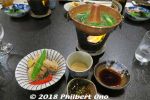
Shorenkan Yoshinoya ryokan is probably more famous for its food, especially crab during crab season (Nov. to March). But it wasn't crab season when we were there so we didn't have any crab. But the food was still excellent. Kyotango, Kyoto Prefecture.
|
|
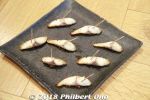
A local fish delicacy called "heshiko." Heshiko is made in this coastal region of Kyoto and Fukui Prefectures. It uses mackerel (saba), sardines (iwashi), or Pacific saury (sanma) that are salted and then fermented in rice bran (nuka). For heshiko, mackerel is most popular and the process takes two years. It is a traditional way to preserve fish for later consumption without refrigeration. It was a common (and cheap) food for the masses, but now it's a delicacy.
This restaurant believes too much salt is not so healthy, so they take only two weeks to salt and ferment the fish. This method is called asazuke (浅漬け) which means "lightly pickled." We sampled the mackerel prepared this way (and grilled), but I thought it was very salty already and hardly any taste of fermentation.
|
|
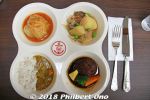
We had a special sample of the curry rice, cabbage roll, stewed hamburger, and potatoes and meat (niku-jaga). Curry rice is famous as a navy dish in Japan.Shoeikan restaurant, Maizuru, Kyoto Prefecture.
|
|

Yakitori
|
|

Yakitori
|
|
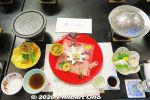
The start of our aesthetic and delicious kaiseki dinner at Kinugawa Park Hotels in Kinugawa Onsen, Nikko. 鬼怒川パークホテルズ
|
|
|
|

Eggplant
|
|
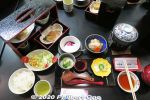
Breakfast at Kinugawa Park Hotels in Kinugawa Onsen, Tochigi.
|
|
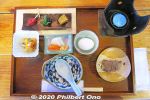
My lunch at Okariba restaurant. At Edo Wonderland in Nikko, Tochigi.
|
|

They serve black bass, Biwa salmon, catfish, and more.
|
|

Appetizers of our full-course, Chinese-style religious vegetarian cuisine at Icho-an. This plate was for four people. Very different, very colorful, and such a unique taste and deliciousness that I've never had before.Fucha ryori is healthy too. Well worth the ¥5,000 which I first thought was quite pricey for a religious meal with no meat. Got stuffed and we could take home some food too.
|
|

Fucha ryori has no fish nor meat.
|
|

A simple bento (box lunch) fucha ryori at Manpukuji temple, Uji, Kyoto 普茶料理
|
|

Saba-zushi or rice topped with mackerel, a local specialty in Obama, Fukui.
|
|

Soba noodles from the soba shop on the platform at JR Ome Station, Tokyo.
|
|
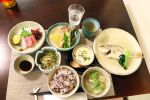
Dinner at Takemori Inn. Chawan-mushi, local fish, Yaeyama soba. The ryokan owner was very friendly. Not English-speaking though.茶碗蒸し、海藻と野菜和え、近海魚の刺身、近海魚の塩煮、煮物(冬瓜)、ソーキ、昆布、こんにゃく、黒紫米入り西表産ひとめぼれごはん、八重山そば
|
|
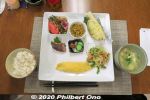
Delicious Okinawan breakfast at Takemori Inn/Ryokan (竹盛旅館).
|
|
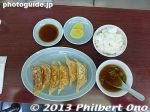
Gyoza with rice
|
|
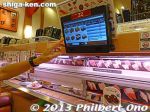
Sushi restaurant
|
|
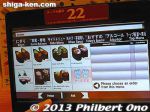
Touch panel ordering for sushi
|
|
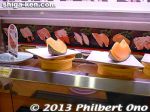
Kaiten Sushi
|
|
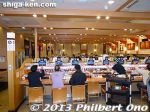
Large Kaiten Sushi restaurant
|
|
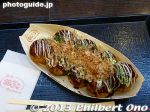
Takoyaki with pieces of octopus inside.
|
|
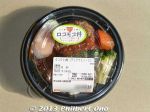
Loco moco bento.
|
|
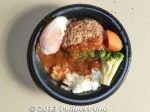
Loco mock with hamburger, gravy, and egg. For only 270 yen at a local supermarket. Not good though.
|
|

Gyudon beef bowl
|
|

Masu trout sushi at Mimasu in Samegai Trout Farm, Shiga Prefecture.
|
|

Dinner at a restaurant near Yudanaka Station. Yasai teishoku or fried vegetables.
|
|
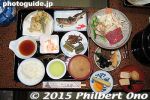
Dinner at Hisamatsu, Shirakawa-go. Includes Hida beef.
|
|
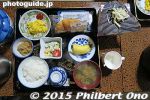
Breakfast at Hisamatsu, Shirakawa-go
|
|

Dinner at Isaburo: River fish and mountain vegetables. After dinner, the proprietress and her husband and daughter sang and danced for us. They demonstrated different traditional musical instruments and had us try playing them. It was great. However, I was told that they don't do that anymore.
|
|
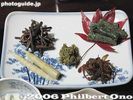
Mountain vegetables 山菜
|
|
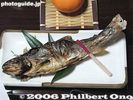
Grilled Iwana river fish
|
|
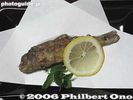
Fried Iwana, eat the head and all.
|
|
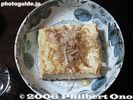
Tofu
|
|
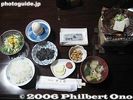
Breakfast at Isaburo minshuku
|
|
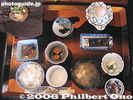
Breakfast at Otaya
|
|

Dinner
|
|

Izushi soba is famous for having cold soba served on five small plates. Dip the noodles in the broth while adding different garnishes like grated yam, onions, and raw egg. 出石そば
|
|

Lots of soba restaurants in Izushi. This lunch cost ¥870. You can also order more plates of noodles. The history of Izushi soba goes way back to the early 18th century when the local lord brought it from Nagano (Shinano soba). 出石そば
|
|
|
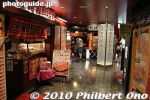
Gyoza restaurants in Utsunomiya Station. The city's gyoza connection started in 1940 when soldiers in the Imperial Japanese Army's 14th Division assigned to a garrison in Manchuria returned to Utsunomiya and brought back gyoza recipes.
|
|
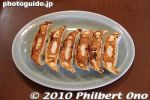
Soldiers in the 14th Division came from Utsunomiya. Sadly in 1944, the division was assigned to Palau and Anguar in the South Pacific where most of them died in bloody battles. What would a trip to Utsunomiya be without eating gyoza?
|
|
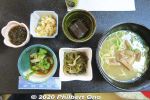
Ishigaki cuisine for lunch. Main dish was soba noodles. Side dishes of pig's ear, goya & tuna, juushi flavored rice (じゅーしー), local seaweed, and brown sugar jelly (dessert). Pig's ear is chewy/crunchy, not really tasty, but has a lot of collagen, so it's a health food.
|
|
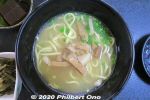
Yaeyama soba noodles
|
|
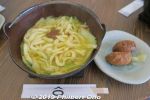
Lunch was Hoto noodles, famous in Yamanashi Prefecture. Thick, flat udon-type noodles in delicious miso-based broth, mixed with cut vegetables. Also came with Inari-zushi. http://www.houtou-fudou.jp/english.html
|
|

Biwako Shokudo restaurant serves its specialty: Tall pile of vegetables in a boiling pot. びわこ食堂
|
|

After cooking, the tall pile of vegetables (mainly Chinese cabbage) shrinks. This is for two people. Chicken and miso broth.
|
|

After you eat the main dish, mixing udon noodles in the miso broth is also good (if you still have room in your stomach).
|
|
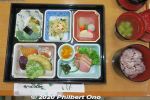
Lunch was named, "Okinawa Makunouchi Bento Akabana" (沖縄幕の内弁当「アカバナ」. ("Akabana" means "hibiscus" in Okinawan.) Price was ¥1,320.Iriomote black rice, champuru, brown sugar yokan: 西表産黒紫米入りごはん、アーサのお吸い物、うみぶどう、ミミガー、漬物、沖縄黒糖煮、 アンダー味噌、野菜天ぷら、ウムクジ(紅イモを米粉であえて揚げたもの)、かまぼこ、チャンプ ルー、黒糖羊羹
|
|
|
|
|
|
|